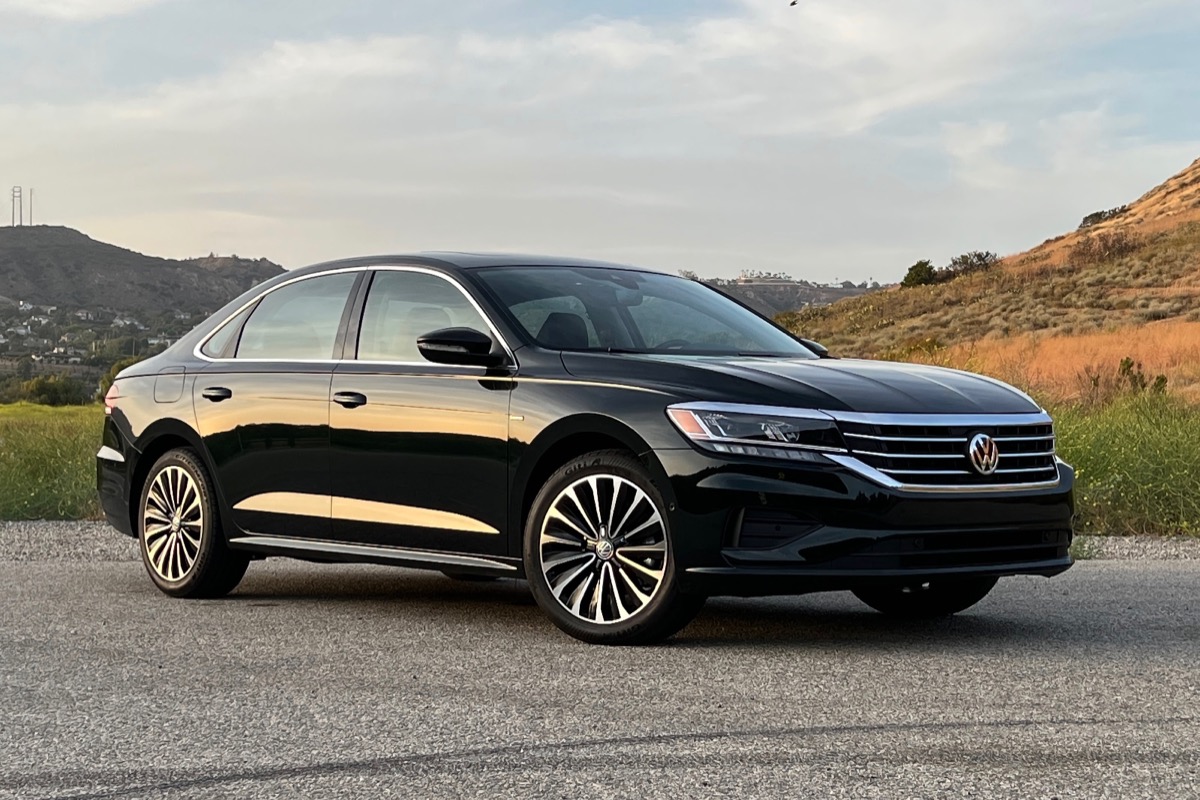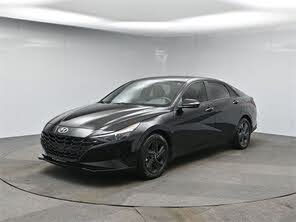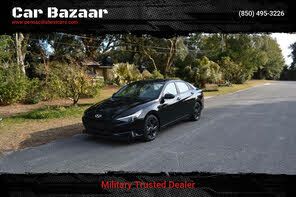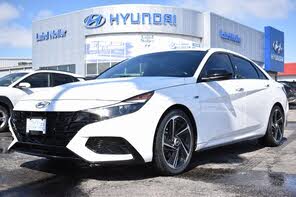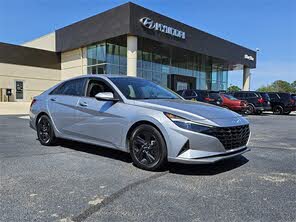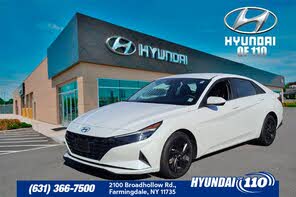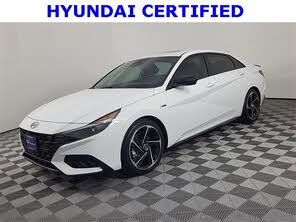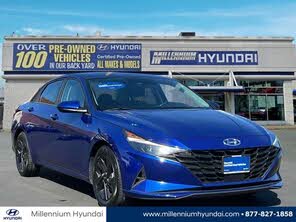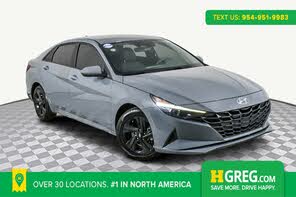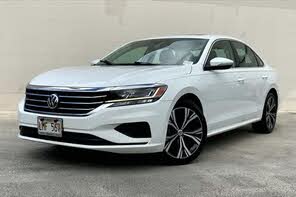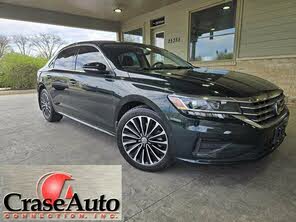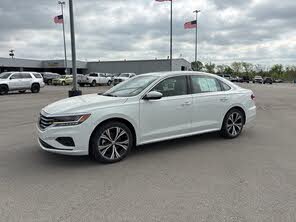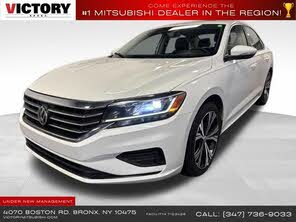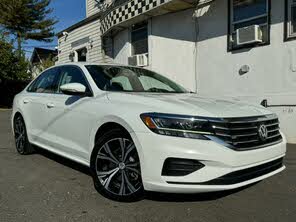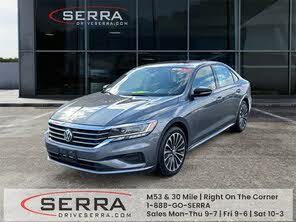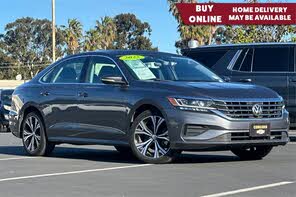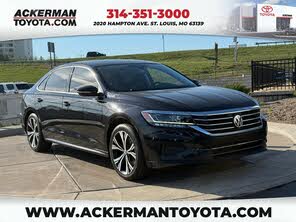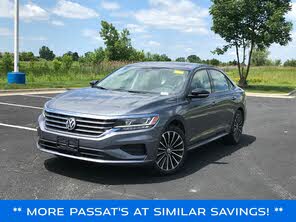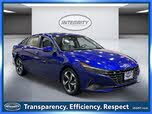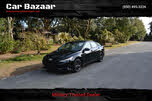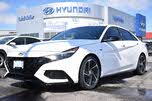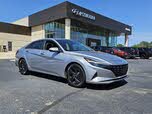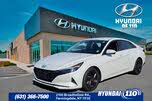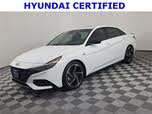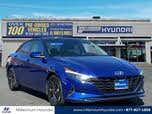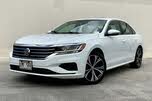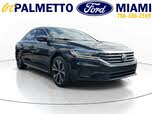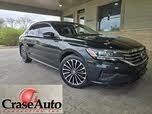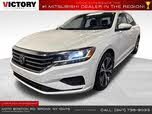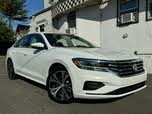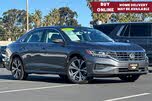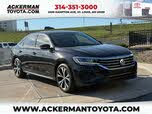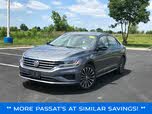2022 Hyundai Elantra vs 2022 Volkswagen Passat
Overview | |
MSRP$20,200 | MSRP$27,575 |
Average price$18,837 | Average price$19,613 |
Listings1132 | Listings246 |
Ratings & Reviews | |
User Reviews | User Reviews |
Expert reviews8.7 out of 10 | Expert reviews6.0 out of 10 |
Pros
| Pros
|
2022 Hyundai Elantra Reviews SummaryFresh off a transcendent 2021 redesign, the 2022 Hyundai Elantra continues to offer stylish exterior design, a roomy cabin, excellent fuel economy, impressive standard safety features and driver-assistance tech, top-notch product quality, and an industry-leading warranty—all at a bargain price. | |
2022 Volkswagen Passat Reviews SummaryFirst came the Dasher in 1974, then the Quantum in 1982, then the Passat in 1990. None became household names like the Honda Accord or Toyota Camry, partly because the Passat and its progenitors appealed to a small contingent of Americans seeking European design, engineering, and driving dynamics in a car often characterized as a bargain-priced Audi. But in the midsize sedan segment, a reputation for reliability and efficiency, not design or handling, is king. Tired of compromise, Volkswagen "Americanized" the Passat for the 2011 model year, moving production to a new factory in Chattanooga, Tennessee. The car's blandly attractive design, huge interior, big trunk, and soft ride seemed to be just what U.S. customers wanted, along with a ”Made in the USA” label. But those potential buyers had moved on to SUVs, and the new Passat alienated some of the VW faithful. The Dieselgate scandal didn't help the Passat, either. VW nailed the car's coffin shut when the family car segment began to wither rapidly. So now, the Passat departs the U.S. market, effectively replaced by the Tiguan and Atlas SUVs and leaving the Jetta to serve people who still want a sedan wearing a VW logo on its grille. | |
No video found | No video found |
Popular Features & Specs | |
Engine2.0L 147 hp I4 | Engine2.0L 174 hp I4 |
Drive TrainFWD | Drive TrainFWD |
Seating Capacity5 | Seating Capacity5 |
Horsepower147 hp @ 6200 rpm | Horsepower174 hp @ 5200 rpm |
MPG City31 | MPG City24 |
MPG Highway41 | MPG Highway36 |
Engine | |
Engine Name2.0L 147 hp I4 | Engine Name2.0L 174 hp I4 |
Torque132 lb-ft @ 4500 rpm | Torque206 lb-ft @ 1700 rpm |
Horsepower147 hp @ 6200 rpm | Horsepower174 hp @ 5200 rpm |
DrivetrainFWD | DrivetrainFWD |
Fuel Economy | |
MPG City31 | MPG City24 |
MPG Highway41 | MPG Highway36 |
Interior | |
Seating Capacity5 | Seating Capacity5 |
Key Features | |
Sunroof/Moonroof | Sunroof/MoonroofStandard |
Safety | |
Front Crash Overall4 | Front Crash Overall3 |
Side Crash Overall5 | Side Crash Overall5 |
Dimensions & Capacity | |
Cargo Space14.2 cu ft | Cargo Space15.9 cu ft |
Curb Weight2725 lbs | Curb Weight3369 lbs |
Height55.7 in | Height58.7 in |
Length184.1 in | Length193.6 in |
Width71.9 in | Width72.6 in |
Wheelbase107.1 in | Wheelbase110.4 in |
Maximum Payload1133 lbs | Maximum Payload937 lbs |
Number of doors4 | Number of doors4 |
Overview | ||
MSRP | $20,200 | $27,575 |
Average price | $18,837 | $19,613 |
Listings | ||
Ratings & Reviews | ||
User reviews | ||
Expert reviews | 8.7 out of 10Read full review | 6.0 out of 10Read full review |
Pros & cons | Pros
| Pros
|
Summary | Fresh off a transcendent 2021 redesign, the 2022 Hyundai Elantra continues to offer stylish exterior design, a roomy cabin, excellent fuel economy, impressive standard safety features and driver-assistance tech, top-notch product quality, and an industry-leading warranty—all at a bargain price. | First came the Dasher in 1974, then the Quantum in 1982, then the Passat in 1990. None became household names like the Honda Accord or Toyota Camry, partly because the Passat and its progenitors appealed to a small contingent of Americans seeking European design, engineering, and driving dynamics in a car often characterized as a bargain-priced Audi. But in the midsize sedan segment, a reputation for reliability and efficiency, not design or handling, is king. Tired of compromise, Volkswagen "Americanized" the Passat for the 2011 model year, moving production to a new factory in Chattanooga, Tennessee. The car's blandly attractive design, huge interior, big trunk, and soft ride seemed to be just what U.S. customers wanted, along with a ”Made in the USA” label. But those potential buyers had moved on to SUVs, and the new Passat alienated some of the VW faithful. The Dieselgate scandal didn't help the Passat, either. VW nailed the car's coffin shut when the family car segment began to wither rapidly. So now, the Passat departs the U.S. market, effectively replaced by the Tiguan and Atlas SUVs and leaving the Jetta to serve people who still want a sedan wearing a VW logo on its grille. |
Video | No video found | No video found |
Popular Features & Specs | ||
Engine | 2.0L 147 hp I4 | 2.0L 174 hp I4 |
Drive Train | FWD | FWD |
Seating Capacity | 5 | 5 |
Horsepower | 147 hp @ 6200 rpm | 174 hp @ 5200 rpm |
MPG City | 31 | 24 |
MPG Highway | 41 | 36 |
Engine | ||
Engine Name | 2.0L 147 hp I4 | 2.0L 174 hp I4 |
Torque | 132 lb-ft @ 4500 rpm | 206 lb-ft @ 1700 rpm |
Horsepower | 147 hp @ 6200 rpm | 174 hp @ 5200 rpm |
Drivetrain | FWD | FWD |
Fuel Economy | ||
MPG City | 31 | 24 |
MPG Highway | 41 | 36 |
Interior | ||
Seating Capacity | 5 | 5 |
Key Features | ||
Sunroof/Moonroof | Standard | |
Safety | ||
Front Crash Overall | 4 | 3 |
Side Crash Overall | 5 | 5 |
Dimensions & Capacity | ||
Cargo Space | 14.2 cu ft | 15.9 cu ft |
Curb Weight | 2725 lbs | 3369 lbs |
Height | 55.7 in | 58.7 in |
Length | 184.1 in | 193.6 in |
Width | 71.9 in | 72.6 in |
Wheelbase | 107.1 in | 110.4 in |
Maximum Payload | 1133 lbs | 937 lbs |
Number of doors | 4 | 4 |
The Hyundai Elantra had always blended quietly into the background, not really catching anyone's eye. It wasn't until the 2021 redesign that things took a dramatic turn. The seventh-generation Elantra got a major makeover, boasting a longer wheelbase, a wider stance, and a lower roofline that gave it a striking four-door-coupe appearance. This transformation distinguished it significantly from the nondescript models of previous years.
While the Elantra's new look shared some similarities with the midsize Sonata sedan, it carved out a unique identity with its own set of distinct features. The elongated and sleek form of the Elantra seemed to execute the sporty coupe aesthetic better than the Sonata. Special attention to the sides of the Elantra revealed a "Z" shape formed by the creases and folds in the doors, adding an extra layer of character and differentiation from both the Sonata and other compact sedans.
Internally, the Elantra saw significant improvements in materials and layout. While some hard plastics were still present, the cabin quality was generally above average for its class. This, combined with advanced tech features, offered a good trade-off considering its starting price of around $20,000.
The Elantra was available in four trim levels for 2022: SE, SEL, N Line, and Limited. The Elantra Hybrid also came in two trims: Blue and Limited. Our test unit was the N Line, draped in Scarlet Red Pearl and featuring a black interior. The N Line featured sporty design elements, including special front and rear fascias, chrome twin-tip exhaust, 18-inch alloy wheels, and N Line-branded sport seats. This trim also incorporated leather-wrapped steering wheels and shift knobs, a black headliner, and aluminum pedals to amplify the sporty vibe.
The Passat, a long-standing member of Volkswagen's lineup, received a special send-off in 2022 with the release of a Limited Edition. Positioned above the base SE and sporty R-Line trims, the Limited Edition carried an MSRP of $31,570 and featured exclusive heritage touches like 18-inch alloy wheels, black mirror caps, and special badges. Each Limited Edition unit, numbering 1,973 in total, commemorated the first year the Passat was sold in Europe.
Our test unit displayed a unique Racing Green paint, creating an element of exclusivity. The Limited Edition also came in other colors like white, gray, and red. Inside, the car showcased Mauro Brown leather upholstery paired with faux wood trim, offering a pleasing contrast against the dark dashboard, carpets, and door panels. Unique seat tags and rubber cupholder inserts added to its special-edition charm.
Despite aging gracefully over a decade, the Passat's interior did reveal its years in certain aspects. While the cabin looked upscale and spacious, it was marred by outdated technologies, including a 6.3-inch touchscreen infotainment system that seemed dwarfed by the expansive dashboard and an archaic small driver information display.
Sophisticated air vents, metallic detailing, and traditional European sober tones provided some modern touches to a predominantly dated interior. Even though the cabin was generally noise-free, the aging vehicle structure occasionally betrayed its age.
The 2022 Elantra had multiple powertrain options catering to various buyer preferences. The base SE, SEL, and Limited trims were powered by a 2.0-liter four-cylinder engine providing 147 horsepower and 132 pound-feet of torque, paired with a continuously variable transmission (CVT). This combination, though adequate for daily driving, lacked power during hard accelerations and produced some engine buzz.
The Elantra Hybrid, designed for fuel economy enthusiasts, combined a 1.6-liter Atkinson-cycle four-cylinder engine with a 32-kilowatt electric motor and a 1.32-kilowatt-hour lithium-ion battery pack. The total output was 139 hp and up to 195 lb-ft of torque, managed by a six-speed dual-clutch automatic transmission (DCT), offering a dynamic driving experience.
For driving enthusiasts, the Elantra N Line packed a turbocharged 1.6-liter engine producing 201 hp and 195 lb-ft of torque. Available with either a six-speed manual or a seven-speed DCT, the N Line featured Drive Mode Select and steering-wheel-mounted paddle shifters in DCT-equipped models. Our test car had the DCT, offering a delightful transmission performance at higher speeds despite being somewhat clunky at low revs.
The N Line's sport-tuned suspension, larger front brake rotors, and multi-link independent rear suspension significantly enhanced ride and handling dynamics. Paired with grippy 235/40R18 tires, the N Line delivered an engaging driving experience, despite the race-inspired seats being less comfortable for long journeys.
The Passat was somewhat of an enigma in the driving department. It floated like an older Buick in most situations, powered by a sole 2.0-liter turbocharged four-cylinder engine producing 174 hp and 206 lb-ft of torque. While adequate for daily driving, this engine felt underwhelming during hard accelerations.
Matched with a six-speed automatic transmission that prioritized fuel economy, the Passat lacked the immediate power often required for aggressive maneuvers like merging onto highways or passing on two-lane roads. However, the engine's torque curve managed to make commuting and cruising a reasonably smooth affair.
The Sport mode helped somewhat by holding engine revs longer, though this typically did not drastically affect fuel economy. Surprisingly, our test loop returned an impressive 30.7 mpg, surpassing the EPA's combined rating of 28 mpg.
With an 18.5-gallon fuel tank, the Passat boasted a long driving range, potentially exceeding 500 miles per fill-up. However, the ride quality was inconsistent, with certain road surfaces and potholes creating jittery sensations. The brake pedal also displayed a tendency for inconsistent response, making smooth stops a challenge at times.
Despite this, the Passat showed commendable handling on twisty roads, revealing its German engineering roots. The car cornered flatly, the steering was light but accurate, and the overall driving dynamics on curvy roads were unexpectedly enjoyable.
Despite its striking design, the Elantra proved very user-friendly. Its compact size made navigating tight spaces effortless, and its controls were clearly marked and accessible. Storage solutions within the cabin were practical, and the seats offered a reasonable level of comfort.
Taking a family road trip in the Elantra was surprisingly pleasant, with enough space in the back for three kids. However, taller adults might find the back seat less comfortable due to limited headroom caused by the sloping roofline. Cargo capacity in the Elantra was 14.2 cubic feet—lower than some rivals but still practical for everyday needs.
The unique shape of the trunk opening, due to the car's sloping roofline, required some maneuvering skills to load large items effectively. One notable minor gripe was the power tilt-and-slide moonroof which produced an annoying droning noise when fully open, a small but perceptible design flaw.
One of the Passat's hallmark features was its spacious cabin. Five adults could comfortably stretch out, enjoying amenities like dual-zone climate control. However, the lack of a height-adjustable bottom cushion in the driver’s seat detracted from its overall comfort, especially for those who preferred sitting higher.
The back seat was exceptionally roomy, with ample legroom and convenient touches like air conditioning vents, USB ports, and coat hooks. The car also provided several storage spaces lined with rubber to minimize noise, although the door-panel bins were lined with hard plastic, which wasn't ideal for certain items.
The trunk space in the Passat measured 15.9 cubic feet, larger than the Elantra's but not quite a class leader. Though spacious, the trunk lacked underfloor trays or side bins, necessitating extra care to secure loose items.
Hyundai packed an impressive array of technology into the Elantra, surpassing expectations for its price range. Standard on the base SE trim were an 8-inch audio touchscreen, HD Radio, wireless Apple CarPlay and Android Auto, Bluetooth with voice recognition, and dual USB ports. Higher trims added satellite radio, Blue Link connected services, and a more advanced audio system.
The Limited and Hybrid Limited trims took things further with a 10.25-inch touchscreen, navigation, an eight-speaker Bose premium audio system, and a fully digital instrument cluster. However, only wired versions of Apple CarPlay and Android Auto were available with the larger touchscreen.
The Hyundai Digital Key was another standout feature, allowing drivers to unlock and start the car via an Android smartphone. Pairing an iPhone with the Elantra N Line was seamless, and the integration was flawless. However, the six-speaker audio system's performance was merely adequate.
The Passat's 6.3-inch infotainment system, though less sophisticated than in other VW models, included App-Connect with Apple CarPlay and Android Auto, SiriusXM satellite radio, and Bluetooth with the capability of pairing two devices simultaneously. Car-Net connected services further expanded its utility, with plans offering everything from WiFi hotspot access to emergency assistance.
The R-Line and Limited Edition trims added HD Radio, onboard navigation, and an excellent Fender premium audio system, which impressed with its clarity and range. Voice command functionality was less than perfect, often struggling with more complex instructions compared to simpler tasks.
Hyundai’s Elantra came equipped with a robust suite of safety features. Standard offerings included forward-collision warning, automatic emergency braking, blind-spot warning, rear cross-traffic alert, lane-keeping assistance, lane-departure warning, and lane-centering assistance. Additional safety features ranged from adaptive cruise control to Highway Drive Assist, the latter working well throughout testing without any false alarms.
The Elantra earned high marks from safety organizations. The NHTSA awarded it five stars for overall crash protection, while the IIHS gave it top "Good" ratings in all six crash tests. It was worth noting that headlight performance varied, with the lower trims receiving a "Marginal" rating and the Limited trim earning a "Good" rating.
While the Passat's safety features weren't as cutting-edge as newer VW models, they were sufficient. Standard features included forward-collision warning, automatic emergency braking, blind-spot monitoring, rear cross-traffic alert, lane-departure warning, lane-keeping assistance, and adaptive cruise control. The R-Line and Limited Edition trims added advanced features like automatic high beams, adaptive headlights, and a parking assist system.
During evaluations, the Passat's lane-keeping assistance was overly sensitive, but other systems worked well. The IIHS granted the Passat "Good" ratings in crash tests and high marks for the top-trim headlights. However, the NHTSA only gave it a four-star overall rating, with a three-star rating for frontal-impact collision protection.
CarGurus highlights
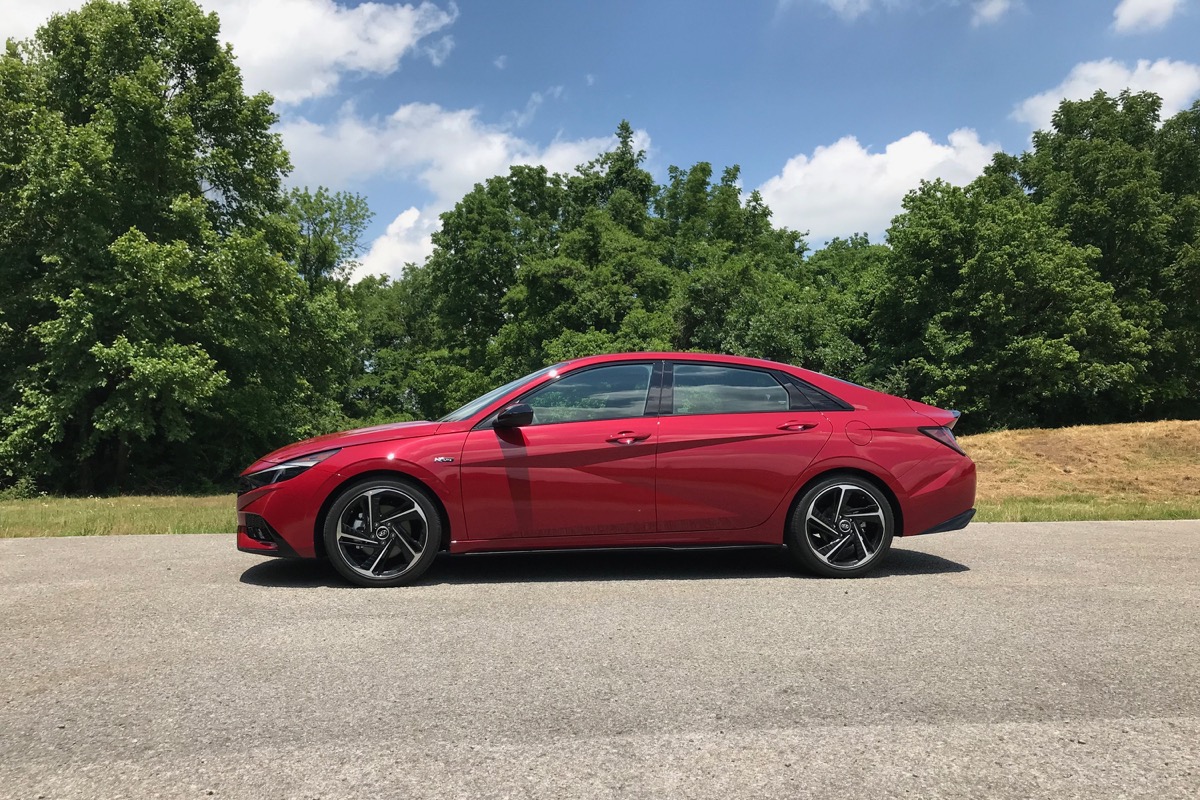
According to CarGurus experts, the overall rating for the 2022 Hyundai Elantra is 8.7 out of 10, while the 2022 Volkswagen Passat scores 6.0 out of 10. Given these ratings, we recommend the 2022 Hyundai Elantra. It stands out with its advanced technology, admirable fuel efficiency, and higher safety ratings, making it a superior choice for most consumers. While the Passat offers a spacious and comfortable cabin, the Elantra's all-around better performance and modern features make it the more compelling option.
Choose the 2022 Hyundai Elantra if:
- You require a small car with advanced technology and safety features at a competitive price.
- You seek excellent fuel efficiency, particularly with the hybrid model.
- You appreciate a striking, modern design both inside and out.
Choose the 2022 Volkswagen Passat if:
- You value a spacious cabin that comfortably accommodates five adults.
- You desire a vehicle with excellent outward visibility and traditional German handling traits.
- You prefer an upscale interior with high-quality materials and a superb audio system.
CarGurus highlights

According to CarGurus experts, the overall rating for the 2022 Hyundai Elantra is 8.7 out of 10, while the 2022 Volkswagen Passat scores 6.0 out of 10. Given these ratings, we recommend the 2022 Hyundai Elantra. It stands out with its advanced technology, admirable fuel efficiency, and higher safety ratings, making it a superior choice for most consumers. While the Passat offers a spacious and comfortable cabin, the Elantra's all-around better performance and modern features make it the more compelling option.
Choose the 2022 Hyundai Elantra if:
Shop Now- You require a small car with advanced technology and safety features at a competitive price.
- You seek excellent fuel efficiency, particularly with the hybrid model.
- You appreciate a striking, modern design both inside and out.
Choose the 2022 Volkswagen Passat if:
Shop Now- You value a spacious cabin that comfortably accommodates five adults.
- You desire a vehicle with excellent outward visibility and traditional German handling traits.
- You prefer an upscale interior with high-quality materials and a superb audio system.

By: CarGurus + AI
At CarGurus, our team of experienced automotive writers remain at the heart of our content operation, conducting hands-on car tests and writing insightful guides that are backed by years of industry experience. To complement this, we are harnessing AI to make our content offering more diverse and more helpful to shoppers than ever. To achieve this, our AI systems are based exclusively on CarGurus content, ratings and data, so that what we produce is both unique to CarGurus, and uniquely helpful to car shoppers.
